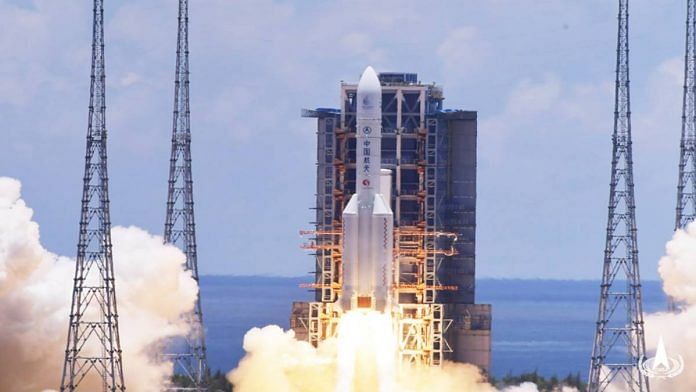Bengaluru: China successfully launched its Tianwen-1 mission to Mars Thursday after keeping the exact details of take-off under a shroud until the final moment. The spacecraft was onboard the Long March 5 rocket, which took off from a launchpad at the Wenchang Spacecraft Launch Site in south China’s island province Hainan.
There was no official live feed — as, for example, with ISRO missions — but the launch was immediately followed by unofficial videos on social media and confirmed by People’s Daily, a state-owned newspaper. Later, the China National Space Administration (CNSA), the country’s space agency, declared the launch a success on social media app WeChat.
The mission consists of an orbiter, a lander, and a rover. Mission objectives are to perform a global and extensive survey of the planet, including searching for evidence of present and past life, mapping the surface and soil composition, as well as its water ice, hunting for reservoirs of underground water, and studying the Martian atmosphere.
The spacecraft is expected to cruise in space for a year before it reaches the Mars orbit in February 2021. Tianwen-1 is one of three Mars mission setting off for Earth’s red neighbour within the month — the Hope mission from the UAE, which took off last week, and NASA’s advanced Mars 2020 mission, which will launch next week.
China is the only country to send a rover to Mars before having sent a solitary orbiter. India’s successful Mars Orbiter Mission, for example, is an orbiter that continues its study of the planet six years since it entered the orbit in September 2014.
China has previously demonstrated its ability to deploy rovers on the moon.
Also Read: Marsquakes and strange magnetic pulses — what NASA’s Mars mission has unveiled so far
Mission payloads and objectives
The Tianwen-1 mission is named after a poem of the same name by famed poet Qu Yuan, who lived around 340 BCE to 278 BCE. Tianwen translates to “Heavenly Questions”.
According to the CNSA, the spacecraft weighs about five tonnes.
After the spacecraft enters into a stable Mars orbit, it will spend two to three months scouting for a landing site inside a basin called Utopia Planitia. Once this is done, the lander will separate and land on the surface using thrusters, a parachute and an airbag. Upon a successful landing, the lander will release the housed rover by opening a ramp.
The 240kg rover will leave the lander’s empty shell behind and move on the surface, performing scientific operations. It can communicate directly with Earth and also via the orbiter.
One of the objectives of the mission is to look for water and water ice distribution in the planet. There is no liquid water on the Martian surface currently, but huge reservoirs of water are believed to have existed in the past, as evidenced by geological formations and mineral residue.
The rover’s radar will probe for locations of underground pockets of liquid water as well, which could have the potential to host life. Subsurface or underground water was spotted by the radar aboard the the European Space Agency’s Mars Express orbiter last year.
The rover will also probe the surface with its radar to perform chemical analyses of soil samples. It will look for biosignatures, which would offer evidence of past or present life.
The orbiter would study the Martian ionosphere in detail as well.
There are reportedly 13 scientific payloads aboard the Tianwen-1 mission.
The orbiter holds seven instruments — two cameras, the Mars-Orbiting Subsurface Exploration Radar, Mars Mineralogy Spectrometer, Mars Magnetometer, Mars Ion and Neutral Particle Analyser, and Mars Energetic Particle Analyser.
The six instruments on the rover are the Multispectral Camera, Terrain Camera, Mars-Rover Subsurface Exploration Radar, Mars Surface Composition Detector, Mars Magnetic Field Detector, and Mars Meteorology Monitor.
The orbiter is expected to operate for at least a year while the rover will operate for 90 sols or Martian days. One sol is approximately 24 hours, 39 minutes, and 35 seconds long on Earth.
Also Read: India must boost start-ups to catch up with China’s private space firms
China’s expansion in space
Tianwen-1’s general landing location, Utopia Planitia, is the largest impact basin on Mars. NASA had landed the Viking 2 mission at the same location in 1976.
This is China’s second attempt at sending a spacecraft to Mars. It earlier tied up with the Russian space agency, Roscosmos, to launch the Fobos-Grunt spacecraft in November 2011, which carried the Chinese Yinghuo-1 orbiter. But the mission failed in low-Earth orbit and could not perform rocket burns to set a path to Mars.
Tianwen-1 is a technology demonstrator and thus not as sophisticated as spacecraft sent by agencies like NASA, now a Mars veteran. Only the American space agency has successfully landed and operated landers and rovers on Mars so far.
China has established technological ability on the moon with its Chang’e mission, which has so far sent two orbiters and two rovers successfully to Earth’s satellite. The Chang’e 4 mission was the first to successfully land and rove the far side of the moon, where it has been operational since last year.
The country is planning for a Chang’e 5 mission to bring back lunar samples to Earth. It is expected to launch in December this year. China also has plans of building a lunar station with humans in 10 years, for which simulation exercises have been underway.
China is also reportedly planning a future sample return mission to Mars.
Its with a similar objective that NASA’s Perseverance rover will launch next week, to collect and store samples from the Martian surface for a future sample return mission.
Also Read: What a simulated Mars mission taught me about food waste






